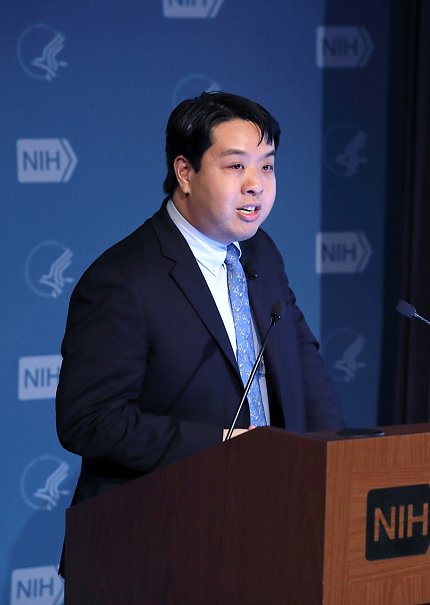Do Microbes, Nervous System Talk to Each Other?

Photo: Chia-Chi Charlie Chang
Dr. Isaac Chiu had an idea for a research project that would cross the body and brain and address important biomedical questions related to pain and microbes.
But it wasn’t clear where his project would fit among the NIH institutes and centers, and its path wouldn’t be entirely known at the start. Could it find a “home” at NIH?
Chiu ended up applying for, and receiving, an NIH Director’s New Innovator Award—a small group of elite awards made to early-career investigators for “exceptionally creative, innovative and high-impact” research ideas.
In a recent lecture, Chiu discussed his work under NIH support, including his New Innovator grant co-funded by NCCIH and the NIH Common Fund. His focus has been the nervous system’s interactions with bacteria (including those in the gut) and how those interactions could influence pain as well as certain infectious and/or inflammatory diseases.
Chiu is an assistant professor of immunology at Harvard Medical School, where he received his Ph.D. in immunology, and his lecture was part of a microbiome series within NCCIH’s Integrative Medicine Research Lectures.
“Pain is something we all experience, and bacterial infections are often painful. Pain is driven by peripheral sensory neurons called nociceptors whose nerve fibers densely innervate barrier tissues [e.g., those of the mouth, gut, skin and respiratory tract] that are exposed to microbes,” Chiu said.
“We have found that the nervous system, like the immune system, has developed ways to directly sense bacteria as well as other pathogens [disease-causing organisms]—through receptors on neurons and molecules produced by bacteria. Neurons are not passive, but signal to the immune system in multiple ways. Pain is also a cardinal sign of inflammation. These connections across systems form an exciting area of research,” he explained.
His research team’s discoveries include that certain distinct bacterial species can activate nociceptors to produce pain and, conversely, that sensory neurons have ways to detect certain bacterial pathogens. An intriguing “flip side” is whether bacteria can not only cause pain, but also silence it.
In one study, his group found that two different bacteria, Streptococcus pyogenes and Staphylococcus aureus, directly activate nociceptors via “pore-forming” toxins, to produce pain in a rodent model. The team then tried delivering a normally membrane-impermeable pain blocker through those same pores. This basically silenced pain more effectively than ibuprofen or lidocaine. Another discovery was that bacteria are dual-action in that they actively try to cause pain, to compromise the immune system and facilitate their own ability to survive.

Photo: Chia-Chi Charlie Chang
Chiu has extended this line of inquiry into questions about the gut microbiome, such as: Does the gut microbiota regulate pain? Could gut microbes have a role in the transition from acute to chronic pain? If so, is that action two-way, with the nervous system also altering the microbiota? Do our drug treatments for pain alter the microbiome?
Chiu thinks that there is a connection between the gut microbiome and pain.
“It’s still early days,” he said, “but there is evidence that nociceptor neurons can respond to different types of gut commensal microbes. The gut microbiome could play an important role in ‘tuning’ chronic pain. Both the nervous system and opioids regulate the composition of the gut microbiome. Maintenance by neurons of a healthy microbiome could be important in gut physiology and host defense. But, above all, the nervous system talks to the gut and vice versa, and I think that’s something we have to think about when treating pain.”
The lecture is available at https://videocast.nih.gov/Summary.asp?Live=31902&bhcp=1.
